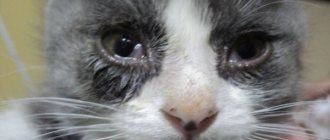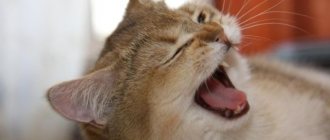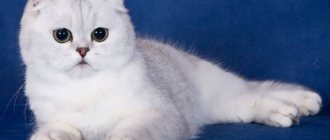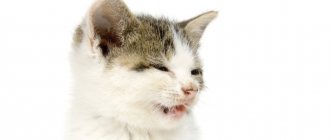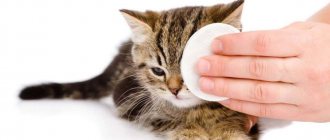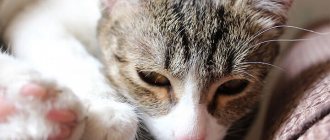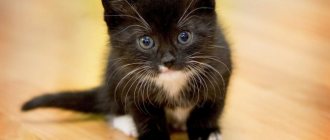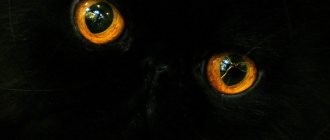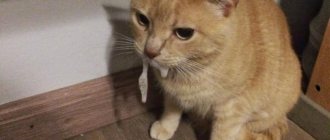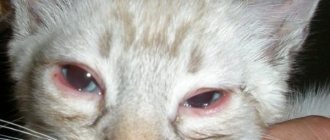“The kitten’s eyes are watering” - quite often the owners of kittens turn to the Bio-Vet clinic with this kind of complaint. Indeed, many cats have a similar problem at an early age and this is one of the main problems of young animals.
If this problem is not eliminated in time, it can have much more serious consequences.
And besides, watery eyes cause kittens considerable discomfort:
- they don't see well
- squint,
- They constantly rub their eyes with their paws.
But in this way it is possible to introduce dirt and foreign bodies into the eyes, which is not the most favorable for health.
The kitten's eyes are watery: normal or pathological
In the first month of life, babies' eyes constantly water, and this is not a disease, but a physiological feature of development. Moisture washes away dust particles, as well as pathogens, while the immune system is not sufficiently developed.
Minor clear discharge after sleep is a common occurrence. However, when lacrimation is constant, you should be wary.
Excessive lacrimation is called epiphora. A characteristic symptom is a tear track on the face. The secretion spreads over the cheeks, dries out, oxidizes, and acquires a reddish-brown color. Wool falls out in areas of constant wetting. The British and Persians are predisposed to such a development of events. The situation requires contacting a veterinarian.
Eye injury, external irritants, cigarette smoke, and pollen cause allergies. In this case, the discharge is transparent. The exudate dries out and sticks the eyelids together. The kitten tears them apart with its paws and introduces opportunistic microflora. Inflammation develops.
The discharge thickens and turns yellow or green. When there is a high degree of intestinal infestation or chlamydia infection, the eyes turn red. In the latter case, first one organ of vision becomes inflamed, then the other.
Be sure to read:
The cat eats poorly and constantly sleeps, is lethargic: normal or pathological, the reason, what to do when you need help
Conjunctivitis is a symptom of dangerous infectious diseases - calcivirosis, rhinotracheitis, panleukopenia, toxoplasmosis.
The kitten's eye is festering and watery
With improper treatment or its absence, serous conjunctivitis, regardless of the cause, turns into catarrhal, and then purulent. If the kitten is not vaccinated, contact a veterinarian. Otherwise, specialized drops are used.
If there are no positive results, seek professional help. The owner's frivolous behavior results in loss of vision in the pet.
In some cases, the eye does not close and a red spot is visible in the middle. This is an inflammation of the nictitating membrane - the third eyelid. In most cases, the predisposition to pathologies is congenital. The eye stops closing, waters, and itches. Rubbing the itchy area with your paws aggravates the situation. In most cases, surgery is required to correct the problem.
The kitten's eyes are watery after eating
Pet lovers are concerned about the tears that the baby produces after eating. After satiation, the kittens' eyes well up with tears. Most often, owners of small Scots complain about the phenomenon. It is possible that there is a congenital anomaly.
Cat lovers change food and with each new diet they note an increase in the volume of eye fluid. In this case, an adaptive response to a change in diet is possible. For most pets, the phenomenon goes away on its own. Most likely, excessive lacrimation after feeding is a hereditary individual developmental feature.
Kitten sneezes and watery eyes
If the kitten was not vaccinated on time, or for some reason there was a breakthrough in immunity, infectious pathologies develop.
High mortality is characterized by panleukopenia, as well as a group of listed diseases called cat flu:
- Calicivirus;
- Herpes (Rhinotracheitis);
- Bordetellosis;
- Chlamydia.
Symptoms resemble those of human flu. If treated improperly or not, the disease leads to loss of vision or death of the pet. The combination of conjunctivitis and rhinitis, the presence of ulcers on the cornea and mucous membrane of the mouth is a serious symptom that requires immediate seeking veterinary help.
Be sure to read:
A cat sneezes and snot: how to treat it at home, the causes of the disease, when it is considered normal
The kitten's brown eyes are watering
Copious tear secretions (epiphora) become brown as they dry out and oxidize in the air. There is a breed predisposition.
Short-faced pets - British, Persians, and Scots - suffer. Brown crusts are, first of all, a cosmetic defect and a harbinger of incipient baldness due to maceration of the skin.
Preventive measures
First of all, watch your pet’s diet. You cannot accustom him to food first, and then feed him the same thing that you eat yourself. A balanced meal intake should be observed daily. We must not forget about the physiological characteristics of this breed and regularly clear the eyes of accumulated fluid. Before giving any medicine or drops, test the medicine on yourself. This is how you will understand if unexpected reactions arise. No smoking near pets
It is important to ventilate the room daily and do wet cleaning. The British eyes are very sensitive, so it is better to get rid of all allergic pathogens, including dust, in advance
If the exact reason why a Briton’s eyes are running is not established, then experimenting with medications is not recommended. Incorrect treatment can cause complications, after which the cat may develop other diseases. Take this issue seriously and do not forget to carry out preventive procedures
Tear discharge may not be dangerous to the cat’s health, the main thing is to pay attention in time and have it examined by a veterinarian
Related publications:
What does a lump on a cat's nipple indicate?
What causes a hard stomach in cats?
How to properly remove an ingrown claw from a cat?
The cat's color has changed: what is the reason?
The kitten's eyes are watering: what to do?
If the discharge is light, the kitten should be monitored. And at the same time, analyze whether the living conditions comply with zoohygienic standards. Are there any drafts in the apartment, does the animal react to tobacco smoke and the owner’s cosmetics. There may be plants in the room that can cause an allergic response in the kitten. If there are other pets in the apartment, the baby reacts to their fur, feathers, and dust.
Next, feeding is analyzed. Does it meet the needs of a growing organism? Do the owners change food without the required weekly transition from one type to another? Do they treat you to human food? Without bringing the housing and feeding parameters into line with the needs of the animal, treatment will not bring the desired results.
Physiological abnormalities
It is possible that kittens are born with abnormalities in the structure of the eyes. A rolled-in eyelid or abnormal eyelash growth will irritate the cornea. Physiological disorders also include stenosis (narrowing of the lacrimal canals). The owner should show the pet to a specialist. If pathology is noticed, it must be eliminated surgically. Excessive tearing can be caused by injuries, foreign objects, or burns. Carefully examine the animal's eyes in good lighting. You may find a speck. Remove it by rinsing or dropping saline solution into the eye.
Treatment of teary eyes in kittens
Medicines to eliminate the disease
If symptoms of conjunctivitis appear that are not accompanied by a depressed state and additional symptoms, you can independently use the following remedies:
- Ophthalmosan is made from extracts of medicinal herbs with the addition of the antiseptic chlorhexidine and a wound healing agent - succinic acid. The drug is indicated as a preventive cosmetic product. cost 15 ml - 154 rub.
- Diamond eyes containing the antiseptic chlorhexidine, the healing component - succinic acid, taurine to increase visual acuity. Cost 10 ml - 160 rub.
- Tetracycline ophthalmic ointment, medical product. Apply under the eyelid several times a day, at night - always. The cost of 3 g in a medical pharmacy is 40 rubles.
Be sure to read:
The cat has red eyes: normal or pathological, symptoms, causes of inflammation, first aid, treatment
If relief does not occur within 2-3 days, contact a veterinarian. Delay threatens vision loss.
The specialist most often prescribes the following remedies:
- Anandin, a dual-use immunomodulator. Place in the nose and eyes. The drug strengthens the immune system and the body copes with the disease on its own. Cost 5 ml - 80 rub.
- Maxidin, a drug similar to Anandin, cost 5 ml - 55 rubles.
- Bars eye drops containing the antiseptics chloramphenicol and furatsilin. Price for 10 ml - 160 rub.
- Iris drops - gentamicin, 10 ml - 150 r.
- Decta-2, contains the antibiotic gentamicin, the hormonal anti-inflammatory drug dexamethasone, 5 ml—110 rub.
Folk remedies
Remedies called folk remedies can be used as an aid to clear crusts and exudate from the eyes before applying medication prescribed by a veterinarian.
Plain water or decoctions of the following herbs are suitable for this purpose:
- Sage;
- Chamomiles;
- Calendula;
- St. John's wort.
When to contact a veterinarian
Examine the cat carefully. If the tears are clean and transparent, without any admixture of pus or blood, there are no signs of swelling, and the cat plays with pleasure and has an excellent appetite, there is nothing to worry about. Your pet does not require treatment, but only proper care.
A visit to the veterinarian is required if the following signs are detected:
- The cat doesn't eat well.
- Her snot is flowing.
- He often scratches his eyes.
- Cloudy or purulent tears.
- Dull eyes.
- The cat is too excited or, conversely, too lethargic.
- The cat's eye is swollen.
- There are deep scratches and cuts around the eyes.
In specialized veterinary clinics they will always be able to accurately determine the diagnosis and correctly state the cause of watery cat eyes.
Features of the physiology of the Scottish cat
Scottish Fold, Straight-eared and British cats are related breeds. Unfortunately, the similarity of these breeds is not limited to their appearance.
The structural features of the faces of these animals often lead to watery eyes. This breed defect is especially pronounced in childhood. Fold-eared Scots suffer the most from lacrimation due to their shortened tear trough.
However, it is not always the case that a Scot’s eyelids are watery due to a breed defect. Quite often, when the eyes are watery, this may indicate some kind of abnormality in the Scotsman’s health.
